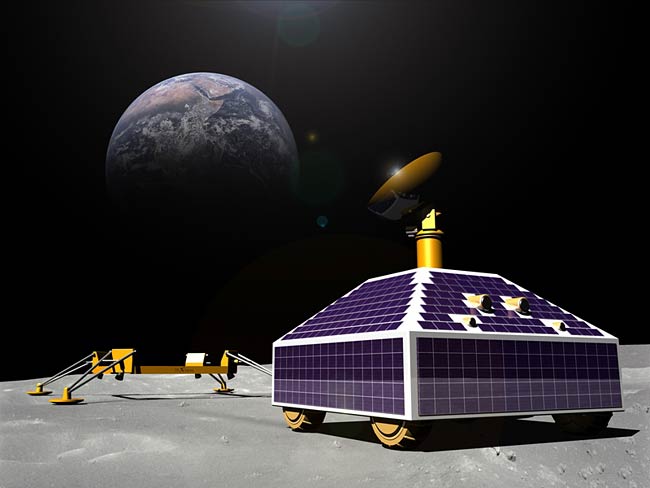Private Firm Reveals Ambitious Moon Mission Plan

A privategroup planning to launch a moon rover to the famed Apollo 11 landing site in abid to win a $20 million prize announced an ambitious plan Thursday to sendfive more spacecraft to explore the lunar poles.
The Pittsburgh,Pa.-based firm Astrobotic Technology, Inc., led by Carnegie Mellon Universityroboticist William "Red" Whittaker, announced plans to launch itsfirst rover to NASA?s Tranquility Base in May 2010 to win the GoogleLunar X Prize competition, the company announced Thursday.
Astroboticis one of 14 teams currently in therunning for the prize, an international competition with up to $30 million ?tothe first privately-funded team capable of landing a mobile spacecraft of themoon, driving it for a third of a mile (500 meters) and beaming homehigh-definition television of the feat. The first team to do so successfully byDec. 31, 2010, wins the $20 million first prize. Second place and bonus prizeseach garner about $5 million.
The competitionis sponsoredby Google and managed by the X Prize Foundation of Santa Monica, Calif.
?It wasvery clear that it was going to cost more to win the prize than the prizeitself,? said David Gump, president of Astrobotic, in a telephone interview.?So we really needed to provide a coherent strategy for a series of missionsthat could benefit investors and get them to come in and fund us up front.?
Under theplan, the inaugural flight would be followed by three more privately-fundedpolar rovers, as well as a lander and a moon dozer, to explore the moon forpotential lunar base sites or scan for water ice, according to a white paperreleased today. Each of the missions is targeted at various high-interest spotson the moon, where Astrobotic probes would observe the lunar surface and theeffects of the lunar environment on spacecraft, as well as test technologiesfor future exploration.
The datafrom each Astroboticmoon shot will be added to a core library and be available for customersfor engineering purposes or scientific research aimed at future exploration,Gump said.
Breaking space news, the latest updates on rocket launches, skywatching events and more!
?As we doadditional missions, it grows richer and more valuable to the space agenciesand the companies that would license access to it,? he told SPACE.com.
Astroboticreleased the new report at a joint meeting of the International LunarExploration Group, Space Resources Roundtable and the Lunar ExplorationAnalysis Group in Cape Canaveral, Fla.
Beyondthe Lunar X Prize
Astrobotic?sfirst mission, the Tranquility Trek, will feature a four-wheeled rover equippedwith cameras and other sensors to observe the lunar surface and Apollo 11landing site. In addition to returning high-definition television views of themoon, the 132-pound (60-kg) rover is expected to study how the remains ofNASA?s Apollo 11 lander Eagle have fared since the July 1969 moon shot andmeasure how lunar regolith builds up on solar panels, Astrobotic officialssaid.
Great carewould be taken to preserve Tranquility Base for its historical significanceduring the mission, Gump said, adding that telephoto camera lenses and smartsoftware would help the mission avoid treading on the boot prints left byastronauts Neil Armstrong and Buzz Aldrin.
Accordingto Astrobotic?s lunar exploration plan, two small rovers would follow theTranquility Trek in 2011 and 2012 on separate ice-hunting expeditions alongcrater rims of the moon?s polar regions. The first would visit the south pole?sShackleton Crater, a potential site for future NASA moon bases, while the otherwould visit a crater rim around the north lunar pole.
A landerwould follow in 2012, touching down at Shackleton Crater for long-term studiesof moonquakes and the lunar environment, Astrobotic officials said. Anotherrover would follow in 2013 to actually roll onto the Shackleton Crater floor tohunt for ice, with a ?moon dozer? to follow later that year to testconstruction and regolith moving techniques.
Futurerovers may eventually also be tailored from existing designs to seekmission-specific data requested by customers, Gump said. Astrobotic has arocket in mind to launch its future fleet of moon probes, but will announce thebooster provider at a later date, he added.
Astrobotic?score of technical rover know-how from Carnegie Mellon and its business base forproject management form a steady platform from which to shoot for the moon,Gump said.
?I thinkwe?ll make this successful, compared to some of the things in the ?90s thatdidn?t work out,? he added.
- Video - Moon 2.0: Join the Revolution
- Private Race to the Moon Takes Off
- Future of Flight: Space Tourism, Investment and Technology

Tariq is the award-winning Editor-in-Chief of Space.com and joined the team in 2001. He covers human spaceflight, as well as skywatching and entertainment. He became Space.com's Editor-in-Chief in 2019. Before joining Space.com, Tariq was a staff reporter for The Los Angeles Times covering education and city beats in La Habra, Fullerton and Huntington Beach. He's a recipient of the 2022 Harry Kolcum Award for excellence in space reporting and the 2025 Space Pioneer Award from the National Space Society. He is an Eagle Scout and Space Camp alum with journalism degrees from the USC and NYU. You can find Tariq at Space.com and as the co-host to the This Week In Space podcast on the TWiT network. To see his latest project, you can follow Tariq on Twitter @tariqjmalik.
